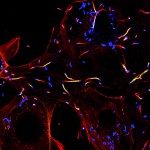Lien vers Pubmed [PMID] – 24598388
Eur. J. Cell Biol. 2014 May-Jun;93(5-6):252-66
Mutations in the human actin depolymerizing factor cofilin2 result in an autosomal dominant form of nemaline myopathy. Here, we report on the targeted ablation of murine cofilin2, which leads to a severe skeletal muscle specific phenotype within the first two weeks after birth. Apart from skeletal muscle, cofilin2 is also expressed in heart and CNS, however the pathology was restricted to skeletal muscle. The two close family members of cofilin2 – ADF and cofilin1 – were co-expressed in muscle, but unable to compensate for the loss of cofilin2. While primary myofibril assembly and muscle development were unaffected in cofilin2 mutant mice, progressive muscle degeneration was observed between postnatal days 3 and 7. Muscle pathology was characterized by sarcoplasmic protein aggregates, fiber size disproportion, mitochondrial abnormalities and internal nuclei. The observed muscle pathology differed from nemaline myopathy, but showed combined features of actin-associated myopathy and myofibrillar myopathy. In cofilin2 mutant mice, the postnatal expression pattern and turnover of sarcomeric α-actin isoforms were altered. Levels of smooth muscle α-actin were increased and remained high in developing muscles, suggesting that cofilin2 plays a crucial role during the exchange of α-actin isoforms during the early postnatal remodeling of the sarcomere.

